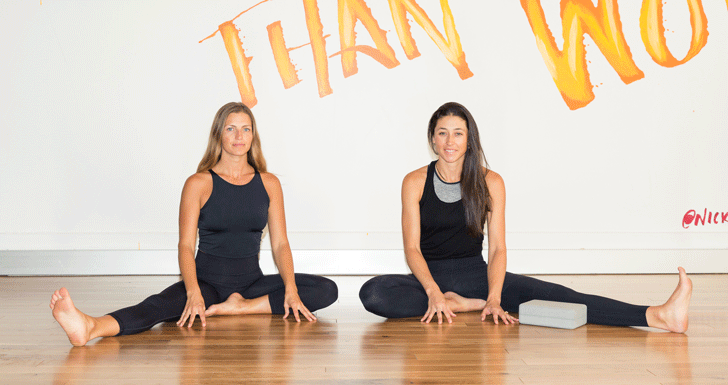Fitness
Yoga Moves to Help You Deal with Anxiety
Like they say, it’s good for the mind, body, and soul.
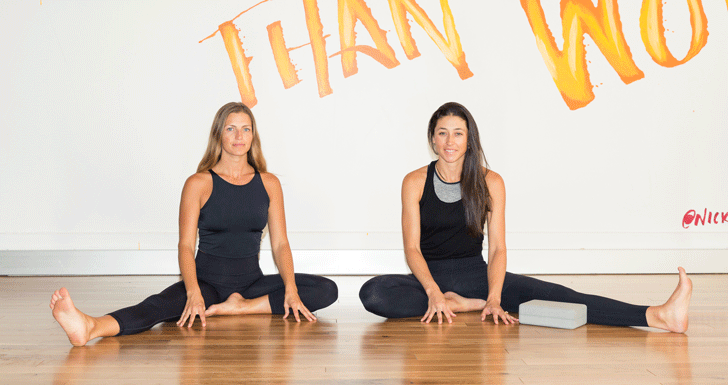
11 September, 2019
Leslie Kirchhoff
10 November, 2021
None of us are immune to a little anxiety—it’s pretty much a given that in our culture, from time to time, we’re going to suffer from a bit of stress. You know the feeling—that tight chest, shallow breath, uncontrollable rolling and racing thoughts. We get it. But when we find ourselves in that mind-set, it’s important to take a moment, breathe deeply, and remind ourselves that it’s really no big deal. So to help us find that inner peace and relief, we turned to Yoga for Bad People’s Katelin Sisson and Heather Lilleston, and Bandier, to give us the best sequence for dealing with our inevitable anxiety.
“When someone is suffering from anxiety, the general state of the breath (which is a physical reflection of the mind) is quick, sharp inhalations, with very little exhalations to balance the inhales. These short inhalations, similar to hyperventilating, lift the chest into a backbend and create a predominance of activity in the left hemisphere of the brain.
“We use this sequence to meet the physical scenario of anxiety, and then rebalance the length of the inhalation with open twists like trikonasana and parivritta janusirsasana, and then lure the body and mind into a more balanced state with forward bends and cooling poses, like the shoulder-stand variation and tarasana at the end. These forward bends highlight the exhalation patterns in the body, therefore restoring the balance we are looking to achieve.
“When in a state of anxiety, we want to bring the body back to a neutral position (somewhere between a backbend and a forward bend). We use the final exercise of nadi shodhana—a powerful pranayama bringing balance to the right and left hemispheres of the brain as well as an evenness to the duration of the inhalation and exhalation to do just this. It’s the cherry on top.
“You always want a gradual descent from anxiety to a calm but awake state of mind. You never want to shock the body or mind. You want to end up somewhere right in the middle. Which is what Yoga for Bad People is all about to begin with: the balance between your spiritual life and the rest of your life. Between yoga and everything else. Always looking for the middle path.”
“We use this sequence to meet the physical scenario of anxiety, and then rebalance the length of the inhalation with open twists like trikonasana and parivritta janusirsasana, and then lure the body and mind into a more balanced state with forward bends and cooling poses, like the shoulder-stand variation and tarasana at the end. These forward bends highlight the exhalation patterns in the body, therefore restoring the balance we are looking to achieve.
“When in a state of anxiety, we want to bring the body back to a neutral position (somewhere between a backbend and a forward bend). We use the final exercise of nadi shodhana—a powerful pranayama bringing balance to the right and left hemispheres of the brain as well as an evenness to the duration of the inhalation and exhalation to do just this. It’s the cherry on top.
“You always want a gradual descent from anxiety to a calm but awake state of mind. You never want to shock the body or mind. You want to end up somewhere right in the middle. Which is what Yoga for Bad People is all about to begin with: the balance between your spiritual life and the rest of your life. Between yoga and everything else. Always looking for the middle path.”
Move #1
Supported Balasana
(Child’s Pose)

From hands and knees, point toes and sit back on your heels, knees apart, resting forehead on a block, with your arms in front resting however is comfortable. Make sure to scrub the skin of the forehead down towards the nose with the block to cool the nervous system. This pose is calming for the mind because it broadens the back body and the back area of the lungs, which enhances the exhalation process while cooling the mind. Being close to the earth like this is very grounding for someone experiencing anxiety. We are reminded of the gravitational pull to the earth that tempers the anxiety jitters. Stay for one minute with natural breathing.
Move #2
Parivritta Janusirsasana
From a seated straddle position on the floor, bend one knee, folding the leg deeply, and place the heel of that foot on its corresponding upper inner thigh. Place the block inside the extended leg, and lean your forearm or elbow onto the block. Reach the other arm up and over your head towards the extended leg’s foot, turning your chest and torso towards the sky. This pose opens up the side body, allowing the lungs and rib cage to receive more breath. It is good for anxiety because it is a slight backbend with added preparation for the more cooling poses of forward bending. So it meets a posture that reflects anxiety (a lifted chest and short, excessive inhalations are generally what someone in a state of anxiety is experiencing), while luring the body into forward bending slowly. You don’t want to shock an anxious body; you want to meet it, and then cool it down slowly, so it ends up in the middle of being awake but calm. Breathe five to ten breaths on one side, then do the other side.
Move #3
Trikonasana
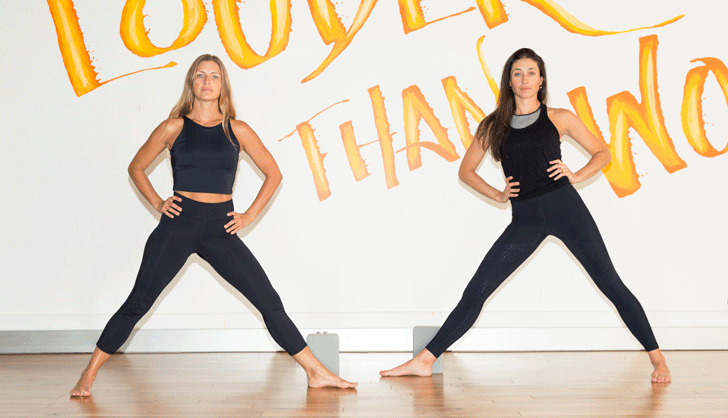
From a standing position, step your feet wide apart so that your ankles are under your wrists when your arms are outstretched. Turn the back foot in 15 degrees and the front foot out 90 degrees. Place a block on the outside of the front foot. Reach forward and place your hand on the block, and reach your top arm up. Turn your torso towards the sky and look up at your top hand. This pose is similar to the one before it, only it builds a little more heat because it is a standing pose, and it lengthens the inner legs slightly differently than parivritta janusirsasana. It opens the lungs and chest and prepares the legs and hips for forward bending. It’s generally a feel-good pose and accessible to most people. Breathe 10 breaths, with even inhalations and exhalations. Do the other side.
Move #4
Prasarita Padottanasana
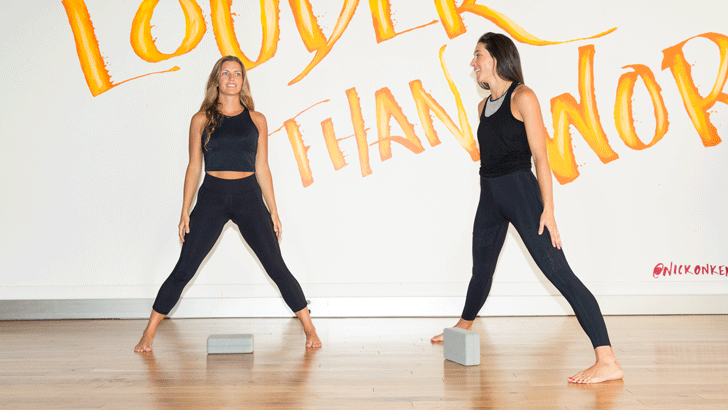
From a standing position, step your feet wide apart so that your ankles are under your wrists when your arms are outstretched. Parallel the feet, hands on hips; lift the chest on the inhale, and fold forward on the exhale. Place the crown of the head on a block for support, and grab the outsides of your ankles or shins. The connection between the crown of the head and either the floor or block is calming for the nervous system, so in this case it is very important to have the crown touching something. Use more than one block or a blanket if necessary. The hamstrings and inner thighs begin to open in this position, which allows for the fight-or-flight instinct (stored in the legs and hips) to settle. This pose takes us into forward bending as well, where it’s easier to exhale, let go, and find a quieter state of mind. You can stay in this pose for a long time, but take your time coming out if you do to avoid being dizzy. It is an inversion, after all. Stand in tadasana (mountain pose) for a few breaths before transitioning into the next pose to neutralize the spine.
Move #5
Supported Shoulder Stand
(Salambha Sarvangasana)
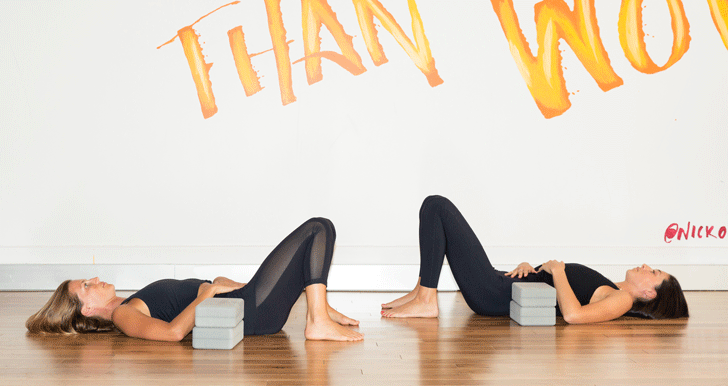
Lying on your back, bend both knees and ground the feet. Lift the hips and place two blocks, stacked on top of each other on their lowest, widest height, underneath the sacrum. Rest the sacrum (low back) on the blocks. Arch your chest so your body is in a backbend position. Lift your feet up and extend the legs in the air, maintaining the backbend position. Hold for three to five minutes. This is a variation of the shoulder stand that removes the pressure on the neck, shoulders, and wrists. The chin-lock position, also known as jalandhara bhanda, is calming for the mind, as well as the support on the sacrum and draining of the legs. Come out gradually so as to let the spine acclimate with the movement and into the next position. Again, you don’t want to shock the body as it moves from backbends to forward bends. Rest on the floor with knees together, feet mat-distance apart for one minute to neutralize the spine.
Move #6
Supported Tarasana
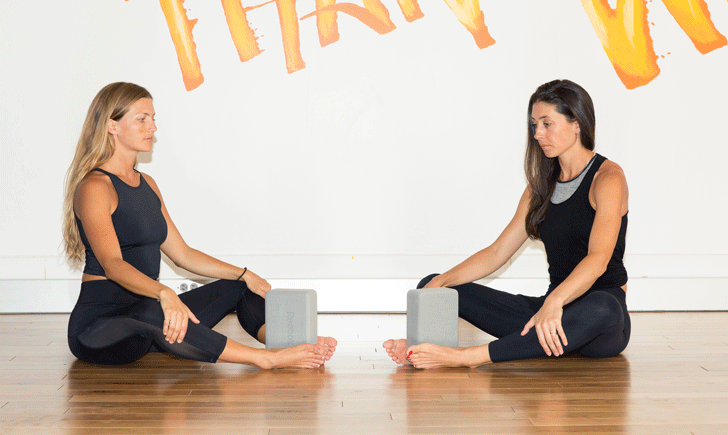
From the floor, roll to one side and come up to sit. Extend the legs in front and slightly bend the knees. Place a block between the soles of the feet, and adjust the distance between you and your feet as needed. Interlace your fingers around the toes. Take a few breaths sitting up. Then fold forward, placing your forehead on the block. Use more props if necessary—the connection of the forehead to a block or a blanket is key in calming the mind. This is a counterpose to the shoulder-stand variation, so we will need to come into it gradually. Stay for about one minute in the forward fold. Sit up gradually.
Move #7
Nadi Shodhana in Virasana
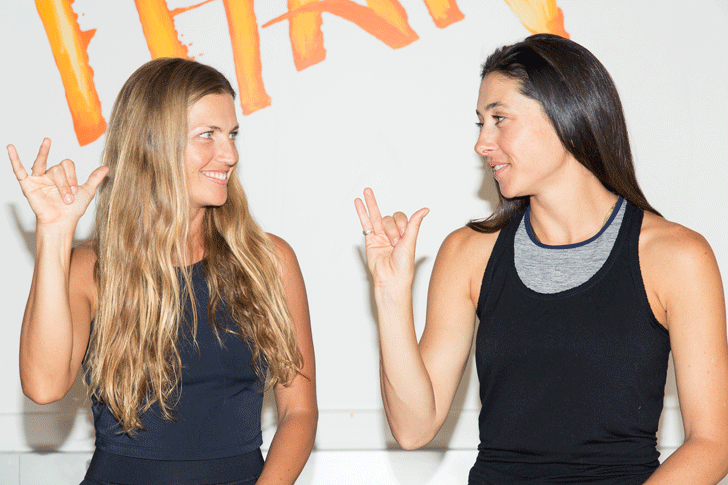
Come to hands and knees. Sit with your knees together and feet apart on a block placed horizontally underneath your seat. Use more props if necessary. Make sure your heels are on the outside of your hips, soles of the feet facing the sky, toenails pressing into the floor. With your right hand, fold your index and middle finger into the thumb pad. Cover your right nostril with your right thumb, then alternate and cover your left nostril with your right ring finger. You will alternate back and forth between right and left nostrils. With both nostrils open, exhale all the breath out. Inhale and close the right nostril with the right thumb, exhale out the left nostril. Inhale through the left nostril, switch the hands, and exhale out the right. Inhale through the right nostril, exhale left. Continue to alternate for about two minutes. This exercise, or pranayama, balances the right and left hemispheres of the brain, which creates balance between the more active side of the brain (the left) and the more calm side of the brain (the right). For someone used to anxiety, this exercise is incredible, and should be done after asana practice and not before.

